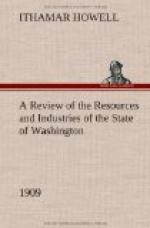COMPENSATIONS.
There are several facts about making farms out of logged-off lands which should not be lost sight of, because they largely compensate for the labor spent in the undertaking. One of these is that the problem of fuel is solved for a lifetime and for the coming generation. Five acres can be left untouched as a reserve and in a remarkably few years it will re-forest itself. [Page 38] The growth of trees under the humid atmosphere of western Washington is astonishing, and a very few years will suffice to provide one with a wood lot to last a generation. Meanwhile some of the fir logs and alder and maple trees will be preserved from the fire and piled up to provide fuel for the years until the wood lot furnishes a fresh green supply.
Then, too, as has already been suggested, the fence question, no small item in a prairie country, is satisfactorily answered with no expenditure but for labor. The cedar logs, splitting with ease, can be turned into rails or boards or posts—preferably the former—and the rails put on top of each other between two posts fastened together at the top make as good a hog-tight and cattle-proof fence as can be desired, and these rails will last in the fence for a century. For the house, doubtless more satisfaction can be had by patronizing the nearest saw-mill, although many houses made out of split cedar timbers and boards are in the state, proofs at once of the usefulness of this timber and the hardihood and ingenuity of the rancher. But for the barn and stable, pig-stye, hennery, chicken-coop and fruit boxes, and a great many other things, the rancher patronizes his reserve log pile instead of the lumber yard, and saves time and labor in so doing. Another fact which compensates the rancher in western Washington in the struggle for a home which will provide a safe and generous support in his old age is that during all the labor and waiting he is enjoying a delightful climate, in which no blizzard drives him from his work. No cyclone endangers his life and fortune. No snakes lurk in the underbrush. No clouds of dust blind his eyes. No sultry summer suns make him gasp for breath, and no intense cold freezes his face or feet. He can work if he wishes as many days as there are in the year, and know that every stroke of his axe or mattock is a part of his capital safely invested that will pay back an annual dividend for a lifetime. No soil will respond to his energy more quickly or more generously.
There is one more possible compensation. Fir logs and stumps and roots and bark are all full of pitch. Factories are now in operation that are turning this wood into charcoal and [Page 39] saving and refining all the by-products, particularly turpentine, wood alcohol, pitch and tar. These factories are successful and paying dividends, but are on a large scale and permanently located. It is probable that some genius will soon evolve a movable plant, capable of serving the same purpose, which can go from one ranch to another. When this is done, it will be found that the refuse left by the logger is worth several times more than the cost of getting it off the land with powder and fire, and, instead of being a burden upon the land of $100 per acre, will become a matter of merchandise to be sold for much more and removed from the land with no expense to the owner.




